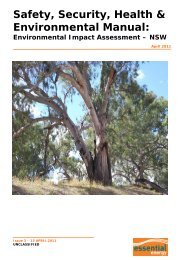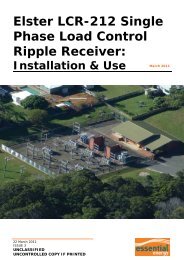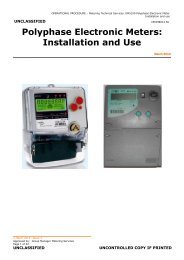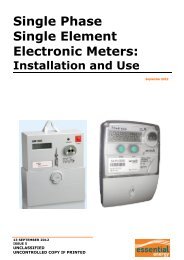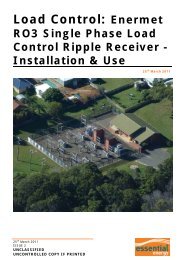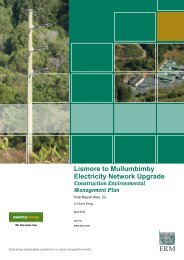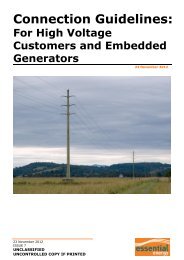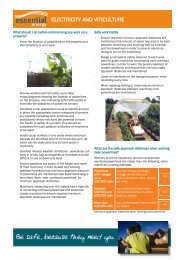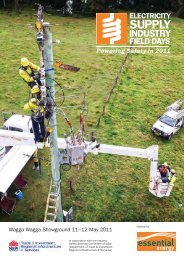Full Version - Essential Energy
Full Version - Essential Energy
Full Version - Essential Energy
You also want an ePaper? Increase the reach of your titles
YUMPU automatically turns print PDFs into web optimized ePapers that Google loves.
Notes to the Financial Statements<br />
for the year ended 30 June 2005<br />
(iv) The assets of EMMLINK Pty Limited<br />
The 30 June 2001 carrying values of the subsidiary’s system assets were independently valued by KPMG Corporate Finance (Aust)<br />
Pty Ltd. The valuations were adopted by the Directors at 30 June 2001 and became part of the Country <strong>Energy</strong> Consolidated<br />
Group at fair value on 1 July 2001. The assets are recorded at balance date at fair value.<br />
(v) The assets of Country <strong>Energy</strong> Gas Pty Limited<br />
The subsidiary’s gas system assets were valued during 2004 by Deloitte Corporate Finance Pty Ltd using a DCF methodology.<br />
The 30 June 2004 carrying values of the assets were supported by the valuation.<br />
The carrying values of the assets at balance date are comprised of the carrying values at 30 June 2004, plus additions less<br />
depreciation. During the period to 30 June 2005 there has been no material change to the expected carrying values of the assets<br />
or assumptions used in the DCF valuation.<br />
The carrying values of the gas system assets at balance date are supported by the independent valuation.<br />
(vi) Asset acquisition<br />
The value of assets acquired during the year includes the cost of acquisition, the cost of materials, labour and an appropriate<br />
proportion of overheads.<br />
73<br />
Assets that are contributed by customers are recorded at fair value (refer note 1(f)(v)).<br />
(vii) Fair Value<br />
Assets are recorded at fair value at balance date. These assets are cash generating assets. They are of a specialised nature and<br />
there is no evidence available to support a market price. The fair value of the assets has been determined by the present value of<br />
future net cash inflows.<br />
(viii) Depreciation<br />
The carrying value of property, plant and equipment is net of depreciation where applicable.<br />
Depreciation is calculated for all items of property plant and equipment, except freehold land, based on the estimated useful<br />
remaining life of the asset. The straight line or reducing balance methods are used.<br />
Depreciation expense is recognised in the Statement of Financial Performance. Accumulated depreciation is written back against<br />
the asset when the asset is revalued.<br />
The estimated remaining lives to the entity for each class of asset are as follows:<br />
Buildings<br />
Leasehold improvements<br />
System assets<br />
Other assets<br />
40 years<br />
Term of lease<br />
5 – 60 years<br />
1 – 10 years<br />
(i) Valuation of Other Non-Current Assets<br />
(i) Investments<br />
Shares held by the corporation in its subsidiaries are eliminated in the consolidated financial statements.<br />
Cash investments are recorded at fair value. Changes to the market value of cash investments are recorded in the Statement of<br />
Financial Performance or the asset revaluation reserve in accordance with Australian Accounting Standard AASB 1041 ‘Revaluation<br />
of Non-Current Assets’.<br />
(ii) Intangible assets<br />
The largest components of intangible assets are Natural Gas Business Licences. These were acquired when the former Great<br />
Southern <strong>Energy</strong> purchased the Natural Gas Business from the Council of the City of Wagga Wagga.<br />
The difference between the cost of the Natural Gas Business and the value of the total assets is the value of the intangible asset,<br />
being Distribution and Retail licences (refer note 13).<br />
These licences entitle Country <strong>Energy</strong> to distribute and retail Natural Gas within the Wagga Wagga region, as well as to other<br />
contestable markets. The licences have been brought to account having regard to the expected net cash flows derived from<br />
holding the licences, and are based on an independent valuation, at the time of acquisition, as part of the allocation of the<br />
purchase price of the assets acquired. Amortisation is over a ten year period on a straight line basis. Nothing has occurred to<br />
suggest the terms and conditions of the issuance of the licences have not been complied with to support the carrying value<br />
of the asset. The values of these licences are reviewed annually.<br />
COUNTRY ENERGY ANNUAL REPORT 2004–2005




